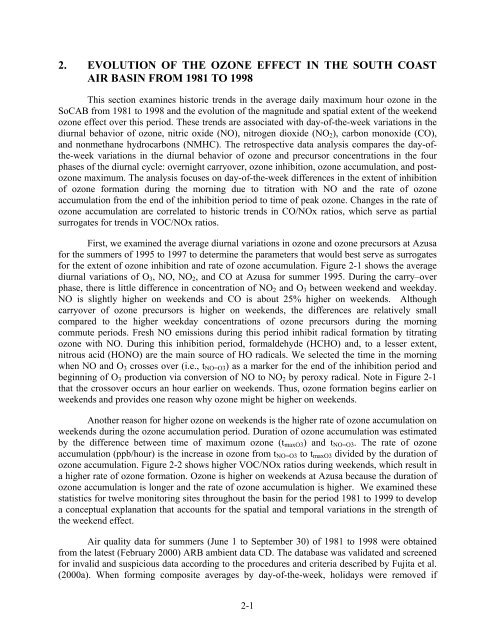Weekend/Weekday Ozone Observations in the South Coast Air Basin
Weekend/Weekday Ozone Observations in the South Coast Air Basin
Weekend/Weekday Ozone Observations in the South Coast Air Basin
Create successful ePaper yourself
Turn your PDF publications into a flip-book with our unique Google optimized e-Paper software.
2. EVOLUTION OF THE OZONE EFFECT IN THE SOUTH COAST<br />
AIR BASIN FROM 1981 TO 1998<br />
This section exam<strong>in</strong>es historic trends <strong>in</strong> <strong>the</strong> average daily maximum hour ozone <strong>in</strong> <strong>the</strong><br />
SoCAB from 1981 to 1998 and <strong>the</strong> evolution of <strong>the</strong> magnitude and spatial extent of <strong>the</strong> weekend<br />
ozone effect over this period. These trends are associated with day-of-<strong>the</strong>-week variations <strong>in</strong> <strong>the</strong><br />
diurnal behavior of ozone, nitric oxide (NO), nitrogen dioxide (NO 2 ), carbon monoxide (CO),<br />
and nonmethane hydrocarbons (NMHC). The retrospective data analysis compares <strong>the</strong> day-of<strong>the</strong>-week<br />
variations <strong>in</strong> <strong>the</strong> diurnal behavior of ozone and precursor concentrations <strong>in</strong> <strong>the</strong> four<br />
phases of <strong>the</strong> diurnal cycle: overnight carryover, ozone <strong>in</strong>hibition, ozone accumulation, and postozone<br />
maximum. The analysis focuses on day-of-<strong>the</strong>-week differences <strong>in</strong> <strong>the</strong> extent of <strong>in</strong>hibition<br />
of ozone formation dur<strong>in</strong>g <strong>the</strong> morn<strong>in</strong>g due to titration with NO and <strong>the</strong> rate of ozone<br />
accumulation from <strong>the</strong> end of <strong>the</strong> <strong>in</strong>hibition period to time of peak ozone. Changes <strong>in</strong> <strong>the</strong> rate of<br />
ozone accumulation are correlated to historic trends <strong>in</strong> CO/NOx ratios, which serve as partial<br />
surrogates for trends <strong>in</strong> VOC/NOx ratios.<br />
First, we exam<strong>in</strong>ed <strong>the</strong> average diurnal variations <strong>in</strong> ozone and ozone precursors at Azusa<br />
for <strong>the</strong> summers of 1995 to 1997 to determ<strong>in</strong>e <strong>the</strong> parameters that would best serve as surrogates<br />
for <strong>the</strong> extent of ozone <strong>in</strong>hibition and rate of ozone accumulation. Figure 2-1 shows <strong>the</strong> average<br />
diurnal variations of O 3 , NO, NO 2 , and CO at Azusa for summer 1995. Dur<strong>in</strong>g <strong>the</strong> carry–over<br />
phase, <strong>the</strong>re is little difference <strong>in</strong> concentration of NO 2 and O 3 between weekend and weekday.<br />
NO is slightly higher on weekends and CO is about 25% higher on weekends. Although<br />
carryover of ozone precursors is higher on weekends, <strong>the</strong> differences are relatively small<br />
compared to <strong>the</strong> higher weekday concentrations of ozone precursors dur<strong>in</strong>g <strong>the</strong> morn<strong>in</strong>g<br />
commute periods. Fresh NO emissions dur<strong>in</strong>g this period <strong>in</strong>hibit radical formation by titrat<strong>in</strong>g<br />
ozone with NO. Dur<strong>in</strong>g this <strong>in</strong>hibition period, formaldehyde (HCHO) and, to a lesser extent,<br />
nitrous acid (HONO) are <strong>the</strong> ma<strong>in</strong> source of HO radicals. We selected <strong>the</strong> time <strong>in</strong> <strong>the</strong> morn<strong>in</strong>g<br />
when NO and O 3 crosses over (i.e., t NO=O3 ) as a marker for <strong>the</strong> end of <strong>the</strong> <strong>in</strong>hibition period and<br />
beg<strong>in</strong>n<strong>in</strong>g of O 3 production via conversion of NO to NO 2 by peroxy radical. Note <strong>in</strong> Figure 2-1<br />
that <strong>the</strong> crossover occurs an hour earlier on weekends. Thus, ozone formation beg<strong>in</strong>s earlier on<br />
weekends and provides one reason why ozone might be higher on weekends.<br />
Ano<strong>the</strong>r reason for higher ozone on weekends is <strong>the</strong> higher rate of ozone accumulation on<br />
weekends dur<strong>in</strong>g <strong>the</strong> ozone accumulation period. Duration of ozone accumulation was estimated<br />
by <strong>the</strong> difference between time of maximum ozone (t maxO3 ) and t NO=O3 . The rate of ozone<br />
accumulation (ppb/hour) is <strong>the</strong> <strong>in</strong>crease <strong>in</strong> ozone from t NO=O3 to t maxO3 divided by <strong>the</strong> duration of<br />
ozone accumulation. Figure 2-2 shows higher VOC/NOx ratios dur<strong>in</strong>g weekends, which result <strong>in</strong><br />
a higher rate of ozone formation. <strong>Ozone</strong> is higher on weekends at Azusa because <strong>the</strong> duration of<br />
ozone accumulation is longer and <strong>the</strong> rate of ozone accumulation is higher. We exam<strong>in</strong>ed <strong>the</strong>se<br />
statistics for twelve monitor<strong>in</strong>g sites throughout <strong>the</strong> bas<strong>in</strong> for <strong>the</strong> period 1981 to 1999 to develop<br />
a conceptual explanation that accounts for <strong>the</strong> spatial and temporal variations <strong>in</strong> <strong>the</strong> strength of<br />
<strong>the</strong> weekend effect.<br />
<strong>Air</strong> quality data for summers (June 1 to September 30) of 1981 to 1998 were obta<strong>in</strong>ed<br />
from <strong>the</strong> latest (February 2000) ARB ambient data CD. The database was validated and screened<br />
for <strong>in</strong>valid and suspicious data accord<strong>in</strong>g to <strong>the</strong> procedures and criteria described by Fujita et al.<br />
(2000a). When form<strong>in</strong>g composite averages by day-of-<strong>the</strong>-week, holidays were removed if<br />
2-1
















